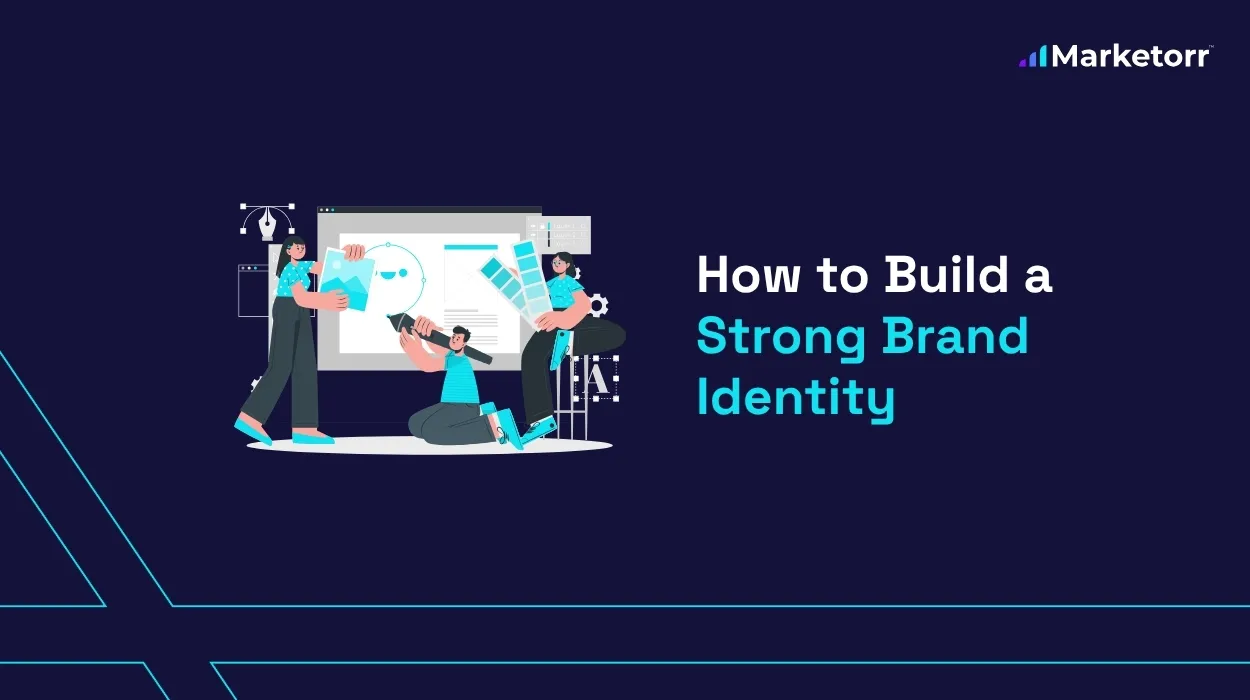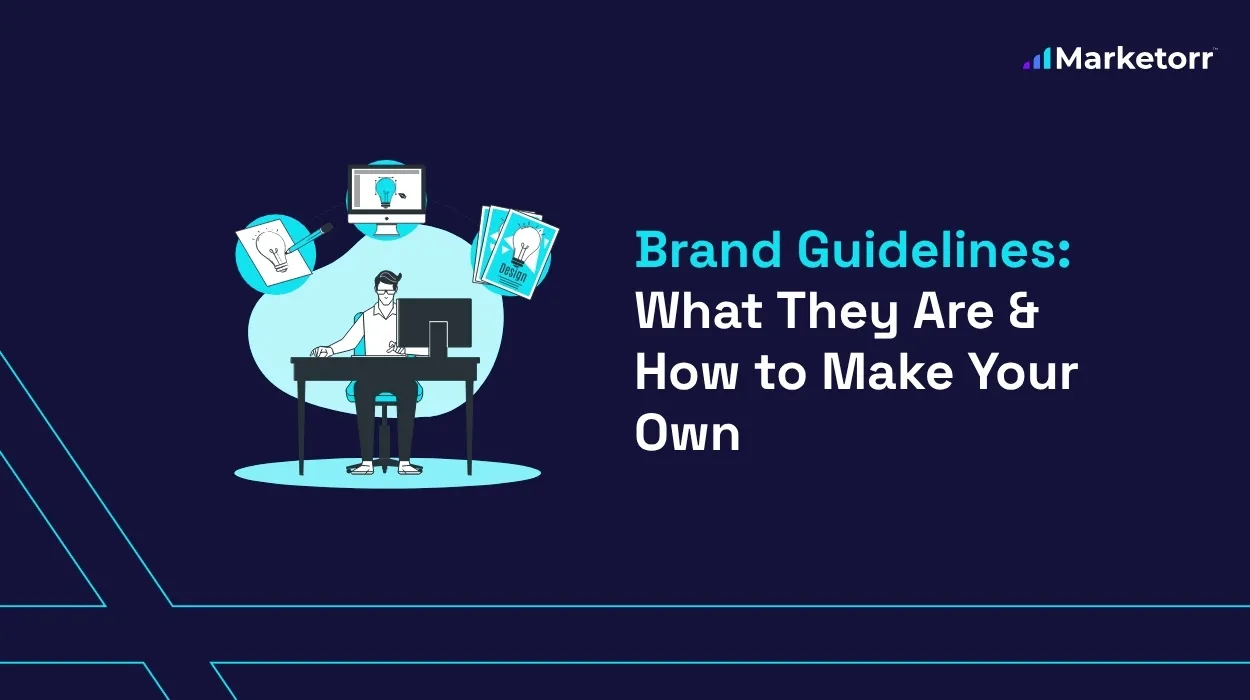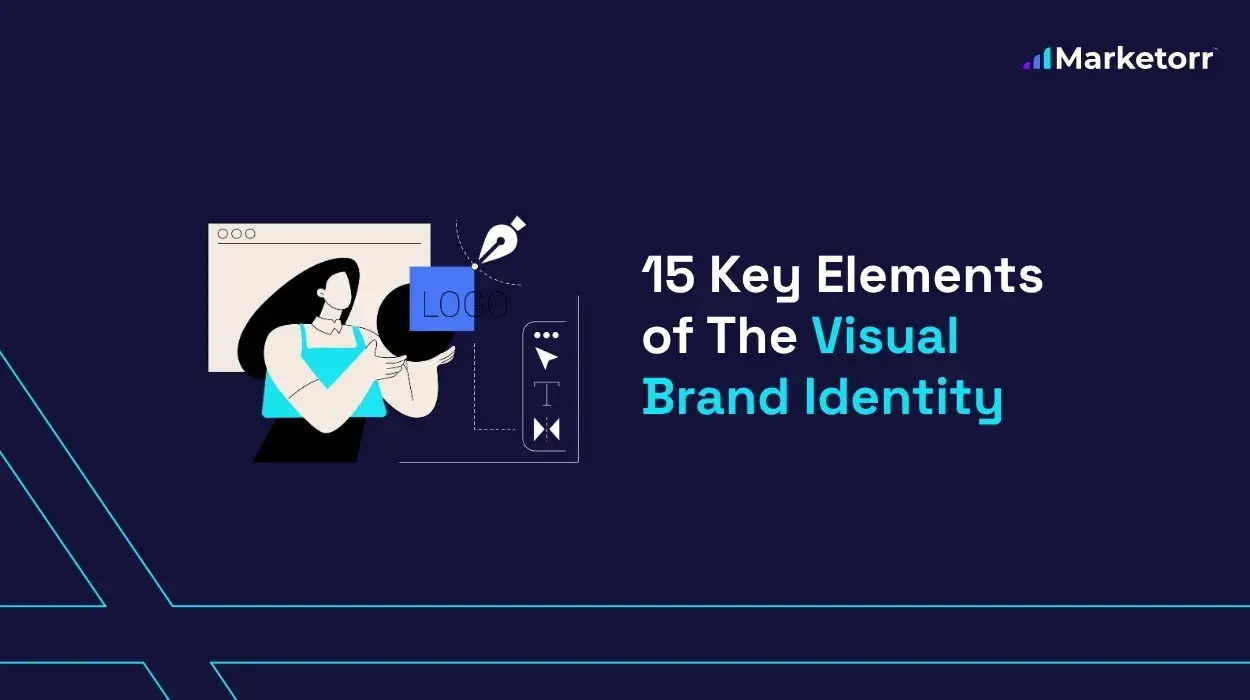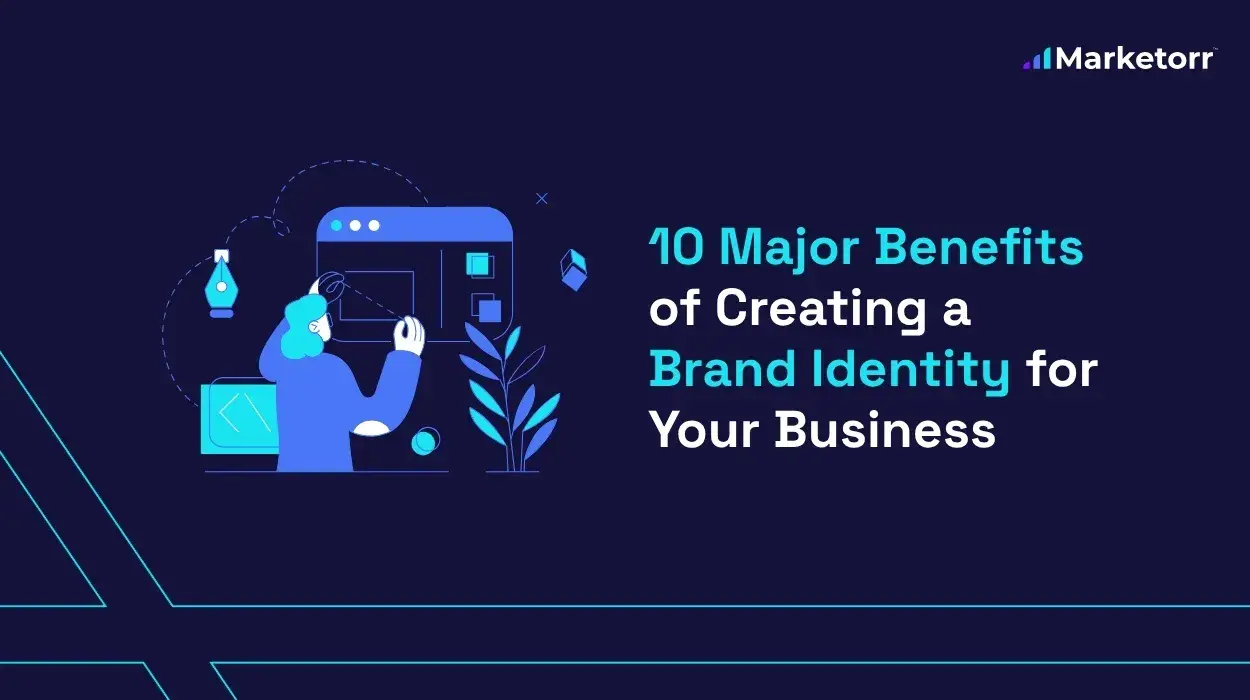Digital marketing has fundamentally reshaped how consumers discover, evaluate, and purchase products. With over 5.35 billion internet users globally as of 2024, online behavior increasingly influences industry decision-making.
A Google study found that 86% of shoppers conduct online research before visiting a store, while 74% rely on social media for purchase inspiration. Personalized ads, user reviews, and mobile-first experiences now guide buying intent more than traditional advertising.
As attention spans shorten and digital touchpoints multiply, understanding the evolving dynamics between marketing efforts and consumer psychology has become critical for businesses aiming to stay competitive.
Data, technology, and shifting user expectations around convenience, relevance, and trust drive this transformation.
What Is Consumer Behavior?
Consumer behavior refers to individuals deciding what they buy, need, want, or use. It includes emotional, psychological, and behavioral responses that drive purchase actions.
Understanding consumer behavior means analyzing how people interact with products or services, from problem recognition to post-purchase reflection. It draws from fields like psychology, sociology, and economics.
In a digital context, consumer behavior expands beyond traditional touchpoints. Browsing history, ad interactions, review analysis, and engagement on social platforms are now vital data points for marketers. These behaviors help businesses tailor content, products, and services more accurately.
Marketing strategies must now account for the fluid, omnichannel paths customers take. Online influence no longer stops at product awareness; it extends through consideration, purchase, and loyalty.
9 Powerful Ways Digital Marketing Is Changing Consumer Behavior
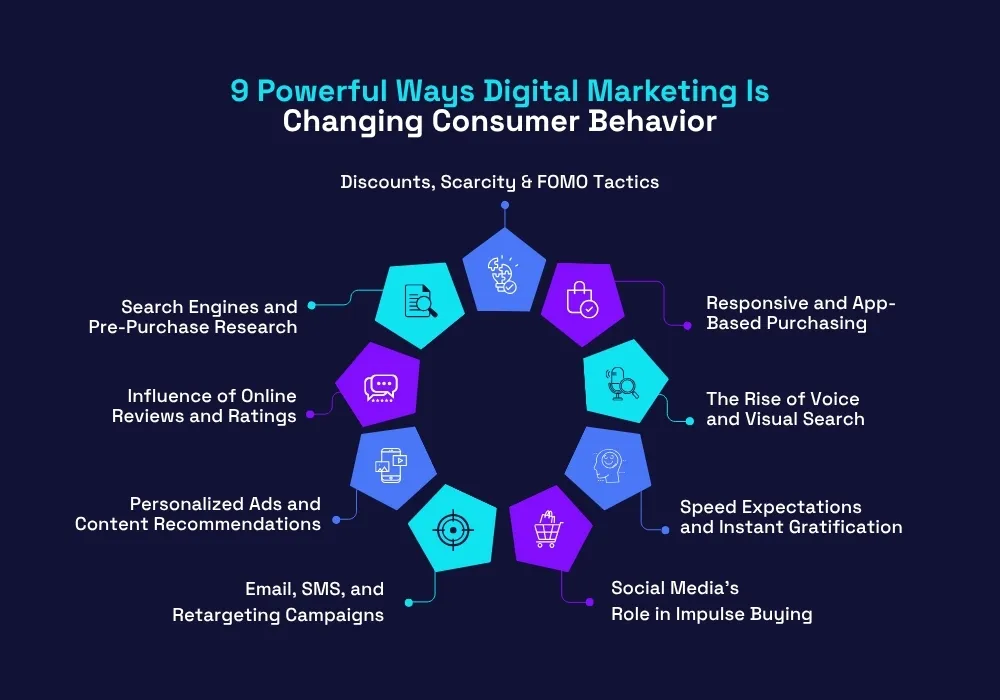
Digital platforms have altered how consumers find, evaluate, and purchase products. Below are nine key areas where behavior has shifted significantly.
1. Search Engines and Pre-Purchase Research
Most buying decisions begin with a search engine query. Consumers often start their journey by researching products or reading about solutions.
According to Think with Google, 53% of shoppers research before purchasing, with search engines being their primary tool. Even in offline shopping, mobile searches influence 82% of in-store buyers.
Google’s algorithm now prioritizes relevance and search intent. Digital marketers must optimize content around long-tail keywords, structured data, and semantic relevance to appear in results and answer user questions.
Individuals no longer visit stores to inquire; they now enter their requirements into a search engine. Brands that present the appropriate content at the opportune moment gain trust and visibility.
2. Influence of Online Reviews and Ratings
Online reviews now act as a digital word-of-mouth engine. Consumers trust peer feedback more than branded content.
According to BrightLocal’s 2023 Local Consumer Review Survey, 98% of people read online reviews, and 76% trust them as much as personal recommendations. Positive or negative reviews can dramatically influence buying intent.
Star ratings, verified purchase tags, and detailed comments help users make quick, informed decisions. Consumers rarely buy without checking ratings or reading a few reviews. This trust-based behavior shift has made reputation management a core pillar of marketing.
For marketers, this means investing in customer experience and encouraging satisfied users to leave feedback. Transparency and responsiveness to negative reviews also impact brand trust.
3. Personalized Ads and Content Recommendations
Personalization has changed expectations. Consumers now expect brands to know their preferences and needs before being told.
Platforms like Facebook, Amazon, and YouTube use AI to serve content based on browsing history, interests, and behavior. According to a report by Epsilon, 80% of consumers are more likely to buy from brands that offer personalized experiences.
Personalized product suggestions, dynamic retargeting ads, and individualized email content increase engagement and drive conversions. If content feels relevant, consumers are more likely to interact with it.
However, the effectiveness of personalization depends on data accuracy and privacy ethics. Consumers know they’re being tracked, and poorly executed personalization can lead to mistrust or fatigue.
4. Email, SMS, and Retargeting Campaigns
Email and SMS marketing remain powerful tools for influencing buying decisions, especially when timed correctly.
Behavioral segmentation allows marketers to send personalized messages based on user actions, such as abandoning a cart, browsing a category, or purchasing a product. These reminders keep the brand at the forefront of consumers’ minds and push them toward a final decision.
According to Campaign Monitor, email marketing delivers an average ROI of $42 for every $1 spent, while SMS campaigns enjoy high open rates, often above 90%.
Retargeting campaigns display ads to users who previously visited a site, helping to recapture lost attention. By staying visible, brands can re-engage users already familiar with their offerings.
5. Social Media’s Role in Impulse Buying
Social media platforms have blurred the line between browsing and buying. Consumers are influenced by what they see on Instagram, TikTok, Facebook, and Pinterest, even if they weren’t planning to purchase.
Social commerce buying directly within apps is growing rapidly. According to Insider Intelligence, social commerce in the U.S. alone will exceed $100 billion by 2025.
Influencers also play a major role. Users trust influencer recommendations more than traditional ads, especially when the promotion feels authentic. Platforms use visuals, storytelling, and peer validation to trigger desire and drive action.
Impulse buying thrives in such environments. A scroll that starts as entertainment can quickly become a transaction, especially with one-click checkouts and time-sensitive offers.
6. Speed Expectations and Instant Gratification
Digital platforms have conditioned users to expect speed. If a website is slow or unresponsive, it loses users.
Google reports that 53% of mobile users abandon a site if it takes longer than 3 seconds to load. Instant gratification, whether it’s product info, delivery, or customer service, fast wins are now standard.
This behavior shift forces businesses to optimize for site speed, streamline user experiences, and reduce friction in checkout processes. If the process takes too long, users drop off.
From food delivery to same-day shipping, consumers now select brands that respect their time. Convenience is no longer a benefit—it’s an expectation.
7. The Rise of Voice and Visual Search
Consumers are interacting with devices in more natural ways. Voice assistants like Siri, Alexa, and Google Assistant enable searches through speech, while tools like Google Lens let users search with images.
Voice searches are often more conversational and longer. For example, instead of “best smartphones,” users might say, “What’s the best smartphone for photography under $1,000?”
This change affects keyword targeting. Marketers must adapt content for question-based queries and structured answers to appear in voice results or featured snippets.
Visual search also enables quicker discovery. Shoppers can snap a picture and find similar items online. Pinterest reports that visual search leads to a 50% higher likelihood of purchase.
8. Mobile-First Behavior and App-Based Purchasing
Mobile devices dominate browsing behavior. Statista says over 58% of global web traffic now comes from mobile devices.
This shift has made mobile optimization essential. Sites must be responsive, fast, and easy to navigate on small screens. Apps take this a step further by offering personalized, seamless shopping experiences.
Retail apps often include loyalty programs, faster checkouts, and push notifications to retain users. Amazon’s app, for example, is designed for speed and convenience, which drives frequent repeat purchases.
Users prefer brands that fit into their mobile habits and remove effort, not add to it.
9. The Psychology of Discounts, Scarcity & FOMO Tactics
Psychological triggers are central to digital marketing success. Limited-time offers, countdown timers, and scarcity messages create urgency.
FOMO(fear of missing out) is a strong motivator. When consumers see “Only 2 left” or “Sale ends in 1 hour,” they act faster. These tactics appeal to the brain’s emotional side, speeding up decisions.
Brands also use social proof, like “500 people bought this today,” to build credibility. Discounts, flash sales, and bundle deals make users feel like they’re getting added value.
These techniques are most effective when paired with authentic branding and user trust. Overuse, however, can reduce long-term credibility.
How Consumer Behavior Shapes Digital Marketing Strategies
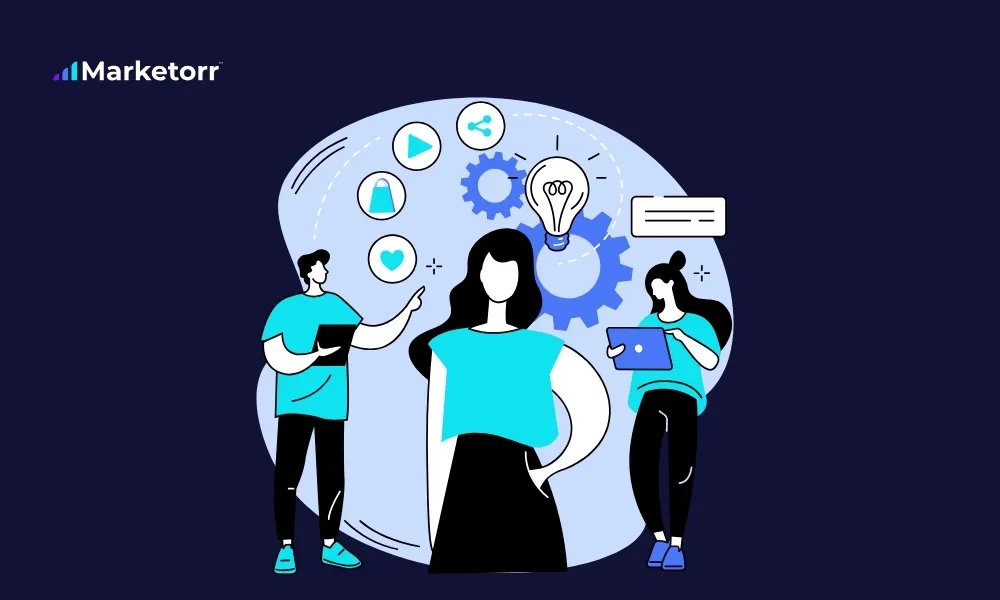
Understanding consumer behavior allows marketers to create smarter, more effective digital strategies. When you know how people make decisions, you can align your content, ads, and offers to match their expectations and emotional triggers.
Today’s marketing strategies are built around data-driven insights. Every click, search, and purchase provides information about what customers want and how they want it. Marketing strategy helps marketers personalize campaigns and refine their messaging across platforms.
Marketers now segment audiences based on behavior rather than just demographics. For example, someone who abandons a shopping cart might receive a reminder email with a limited-time discount.
A returning website visitor may see a product recommendation based on previous views. This level of customization is only possible when behavior is analyzed and applied.
Ethical Considerations in Influencing Consumer Decisions
While digital marketing can powerfully influence decisions, it also raises important ethical concerns. How brands use data, design experiences, and communicate offers must respect consumer rights and autonomy.
One major concern is privacy. Consumers are increasingly aware of how their data is collected and used. According to a Cisco consumer privacy survey, 86% of people care about data privacy and want more control over their data.
Tracking tools like cookies or pixels to serve personalized ads must be transparent. Marketers should disclose data practices and obtain consent. Laws like the GDPR and CCPA have made this a legal requirement in many regions.
Another ethical issue involves manipulation tactics. Urgency triggers like countdowns or scarcity messages can pressure users into rushed decisions. While effective, they can cross into exploitation if not used responsibly.
Marketing should focus on helping consumers make informed, positive decisions rather than forcing action through fear or confusion. For instance, presenting clear pricing, offering easy opt-outs from email lists, and avoiding misleading claims can build long-term trust.
Vulnerable groups, such as teenagers or older adults, may also need protection from aggressive marketing. Ethics in digital marketing isn’t just about compliance—it’s about responsibility and care for the audience’s well-being.
Brands prioritizing transparency, honesty, and empathy often enjoy stronger loyalty and better reputation, proving that ethical marketing is also good business.
Predicting Future Behavior
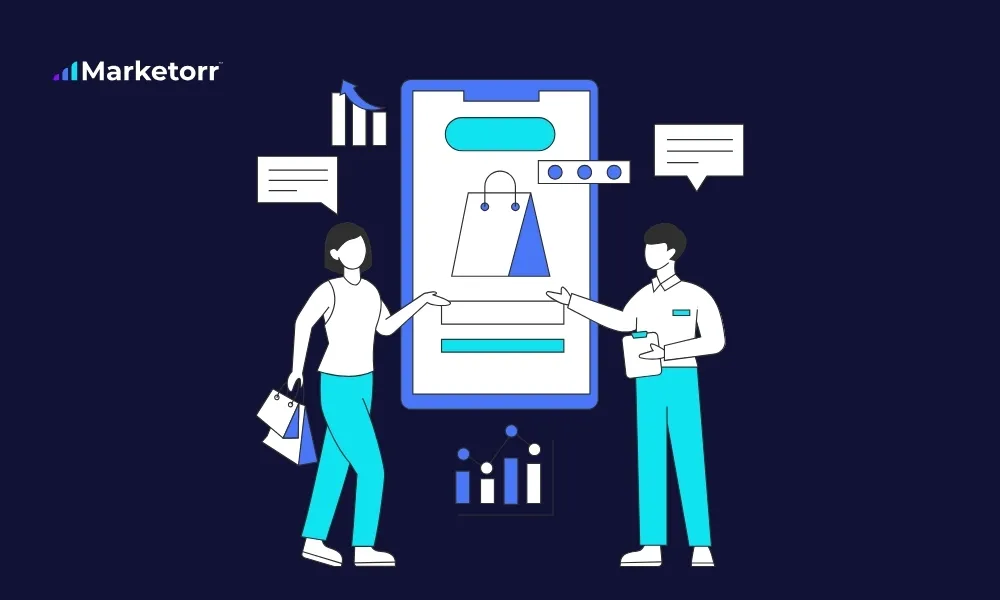
The future of marketing lies in prediction. By analyzing past behavior, marketers can anticipate what consumers will likely do next and respond in real-time.
Predictive analytics uses machine learning and large datasets to find patterns. These insights help brands forecast trends, personalize offers, and plan inventory or product launches.
For example, Netflix uses viewer behavior to recommend shows and predict what content will be popular next. Based on browsing and purchase history, Amazon predicts what customers might need, enabling faster fulfillment and better recommendations.
This approach goes beyond targeting to create proactive experiences, like sending a discount email when a customer is ready to reorder or suggesting new fitness routines based on past workouts and goals.
According to Salesforce’s “State of Marketing” report, 71% of marketers now use AI to improve personalization and anticipate customer needs.
Behavioral data also helps identify churn risk. If a customer suddenly stops engaging, the system can trigger a loyalty offer or feedback request to re-engage them.
AI and predictions need human oversight and transparency. Consumers should feel guided, not watched, as trust remains vital in a data-driven future.
FAQs About Digital Marketing and Consumer Behavior
How Has Digital Marketing Changed the Way People Shop?
Digital marketing has transformed shopping by making it faster and more convenient. Consumers can now research products, compare prices, and read reviews from their devices. Targeted ads, influencer recommendations, and AI suggestions introduce users to new products, making shopping impulsive and deliberate.
What Factors Most Influence Online Buying Decisions?
Online buying behavior is influenced by several factors, with trust being paramount. Consumers look at reviews, ratings, and return policies before making purchases. Key elements include product quality, website experience, pricing, delivery speed, brand reputation, visual content, personalization, and mobile usability.
How Can Marketers Ethically Influence Consumer Behavior?
Marketers can influence behavior ethically by focusing on transparency, education, and value. That means being honest in messaging, respecting data privacy, and avoiding deceptive tactics.
Providing helpful content, empowering users with information, and creating fair promotions can drive decisions without manipulation. Ethical marketing builds loyalty and sustainable success.
Final Thoughts
Consumer behavior is no longer passive. People actively research, compare, and evaluate before making a purchase, and they do it quickly. Digital marketing has transformed how brands connect with audiences, but with that power comes responsibility.
To stay competitive, businesses must deeply understand their audience’s digital habits. That means embracing data, personalizing experiences, and delivering real value. It also means staying ethical, responsive, and human in every interaction.
The brands that thrive today don’t just chase attention; they earn trust, adapt fast, and serve their customers better than anyone else.
To get the best and most qualified digital marketing service, contact Marketorr.


